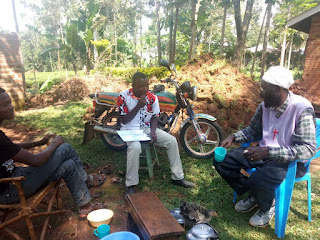Saniaga Oral Genealogy at start
We are on. Saniaga Oral Genealogy Documentation. Mwandihi and I are doing a mock family tree search to test on our tools of data collection. The process is already an interesting one, a broader explanation here;-
Interesting.
You enter a Saniaga home for family tree info. You are warmly welcome. The session starts with a light introduction.
Much is not expected from the interviewer due to previous interactions of Saniaga activities. Nor the respondent in unnecessary doubt of the questioner. A rapport is easily struck.
The respondents are preferably over 50 years. We therefore need to strike out Email as part of their details required from them. That is one of the areas at the questionnaire to edit. Among a few others.
To start, the youngest member of a family is mentioned. A child of 1-5 years probably. The respondent could be the grandfather or the great grandfather. The questionnaire starts at the young one. The father/mother is next, the grandfather(Saniaga), the great grandfather ...and so till the respondent reaches for the last memorable ancestor. That is part B.
It is in part C we build on the mentioned young one. The mother and clan if he/she is a Saniaga. If he/she is mwifwa, we note the father at the Mf(mother/father and clan). The next column is in stating the siblings to the young one, brothers and sisters, their locations and contacts. If underage we asign '-' and dead 'D'.
It interests when you find the young one has step mothers. The respondent may not be knowing the mothers. 😊. A listening wife/grandmother/great grandmother comes to rescue the respondent male. She lists the wives, she lists their clans. She says the children they have. Their ages are assumed 2 years apart and when we position the youngest member at the right place of birth in the nuclear part we calculate the ages of the rest backwards. We also operate on assumption that a generation is 30years away from another when we can't know birth years of mentioned ancestors.
In case of a father who is non Saniaga or a child who came with the mother, we note them well at MF alike as we would comfortably note mothers, assigning them their clans if known. We have a notes area at the left for the interviewer to note such scenarios.
We go to part D and seek for the father/mother of the first person in the questionnaire. It is a Saniaga. We list their mother(s) at the MF. We remember to list Fathers in case the child/children came with the mother. We note accordingly on the left. We update on the following column the siblings, starting from oldest in that order till we position him/her at the right order. It is this productive age that we are highly interested with their contacts for the database and near future working.
It happens that dynamics are experienced as in the first scenario. They are the modern history makers, their story told as if happening... You can have a touch of history in the making.
Here, we do not rush to the generation of the grandfather. We dwelve into the siblings. One by one. If married and with children, we get a new page and equally mark it 1.0 a cousin of the very first child in this article. If they are for instance five uncles and four aunts we shall have to dig all that before we go to part E.
Part E is at the grandfather stage. We may be now at the mother/mothers of the respondent if he was the grandfather of the first child. He tells us the story. Listing siblings. Locations of living/death. Sisters are mentioned. Where did they get married to.... We again dwelve in such a reverse manner now to find those who would call this grandfather of ours an uncle, their siblings, their children and their grandchildren. So far we could be talking of more than 200 people.
It shall then go to F, great grandfather and so followed as in the mentioned manner. With notes being taken.
In the end, we shall have a largely covered tale of an extended family, on paper. It takes at least 5 hours to record an average of 6 people per part.
Interesting.
It does not end there. The respondent is now open with even more. The nitties, the whys. A woman was mentioned somewhere. Why? A man died. Why? Where? Causes?
Such stories that would be termed Saniaga Tales. Talk of human nature, talk of life, talk of a people. Any writer and curious mind would want to get at the heart of it all and know more. It comes with the right questions. The forum is open and it is soul to soul, Saniaga to Saniaga moment. The best of it all.
It is going to be fun, from the mock. Names are going to crop, familiar and the unfamiliar with possible origins noted. We are going to learn what was rather thought not worthy. We are going to have a new look at us and in such better understanding rediscover our identity and work out the best way forward.
With Thanks

Comments
Post a Comment